Spatiotemporal Variability of Soil Erosion in the Pisha Sandstone Region: Influences of Precipitation and Vegetation
Abstract
1. Introduction
2. Research Methods
2.1. Overview of the Research Site
2.2. Data Sources
2.3. Forecast of Soil Denudation
3. Temporal and Spatial Changes in Land Use and Vegetation Cover in the Study Area
3.1. Analysis of Spatial-Temporal Dynamic Changes in Land Use in the Study Area
3.2. Temporal and Spatial Dynamic Changes in Vegetation Cover in the Study Area
4. Temporal and Spatial Variation of Soil Erosion in the Study Area
5. Analysis of the Effects of Vegetation and Rainfall on Soil Erosion
5.1. The Influence of Vegetation and Slope on Soil Erosion
5.2. The Impact of Slope and Rainfall on Soil Erosion
5.3. The Impact of Vegetation and Precipitation on Soil Erosion
6. Discussion
7. Conclusions
Author Contributions
Funding
Institutional Review Board Statement
Informed Consent Statement
Data Availability Statement
Conflicts of Interest
References
- Wang, T. Soil Erosion Is Influenced by Grain for Green Policy in Loess Plateau Area of Northern Shaanxi, China. Int. J. Environ. Prot. Policy 2015, 3, 129–136. [Google Scholar] [CrossRef]
- Xu, F.; Li, Y. The Evaluation Indexes System of Comprehensive Effect of the Project of Returning Grazing Land to No Grazing Land and a Case Study. Chin. J. Grassl. 2008. [Google Scholar] [CrossRef]
- Zhang, X.; Zhang, L.; Zhao, J.; Rustomji, P.; Hairsine, P. Responses of streamflow to changes in climate and land use/cover in the Loess Plateau, China. Water Resour. Res. 2008, 44. [Google Scholar] [CrossRef]
- Bai, X.; Jia, X.; Zhao, C.; Shao, M.A. Artificial forest conversion into grassland alleviates deep-soil desiccation in typical grass zone on China’s Loess Plateau: Regional modeling. Agric. Ecosyst. Environ. 2021, 320, 107608. [Google Scholar] [CrossRef]
- Zhou, Z.; Shangguan, Z.; Zhao, D. Modeling Vegetation Coverage and Soil Erosion in the Loess Plateau Area of China. Ecol. Model. 2006, 198, 263–268. [Google Scholar] [CrossRef]
- Ito, A. Simulated impacts of climate and land-cover change on soil erosion and implication for the carbon cycle, 1901 to 2100. Geophys. Res. Lett. 2007, 34. [Google Scholar] [CrossRef]
- Yang, Z.; Qin, F.; Yu, X.; Li, Y.; Ren, X. Relationship between Soil Particle Size and Fractal Dimension under Different Forests of a Small Watershed in the Feldspathic Sandstone Region. Chin. J. Soil Sci. 2019, 50, 829–832. [Google Scholar]
- Yang, Z.; Qin, F.; Zhang, X.; Li, X.; Niu, X.; Liu, L. Environmental interpretation of herb species diversity under different site types of Hippophae rhamnoides forest in feldspathic sandstone region. Acta Ecol. Sin. 2018, 38, 5132–5140. [Google Scholar] [CrossRef]
- Wang, F.; Mu, X.; Li, R.; Fleskens, L.; Stringer, L.C.; Ritsema, C.J. Co-evolution of soil and water conservation policy and human–environment linkages in the Yellow River Basin since 1949. Sci. Total. Environ. 2015, 508, 166–177. [Google Scholar] [CrossRef]
- Wischmeier, W.H.; Smith, D.D. Predictiing Rainfall Erosion Losses, a Guide to Conservation Planning; U.S. Department of Agriculture, Agriculture. Handbook No. 537; US Government Publishing Office: Washington, DC, USA, 1978.
- Thapa, P. Spatial Estimation of Soil Erosion Using RUSLE Modeling: A case study of Dolakha District, Nepal. Environ. Res. 2020, 9, 15. [Google Scholar] [CrossRef]
- Aiello, A.; Adamo, M.; Canora, F. Remote sensing and GIS to assess soil erosion with RUSLE3D and USPED at river basin scale in southern Italy. CATENA 2015, 131, 174–185. [Google Scholar] [CrossRef]
- Galdino, S.; Sano, E.E.; Andrade, R.G.; Grego, C.R.; Nogueira, S.F.; Bragantini, C.; Flosi, A.H.G. Large-scale Modeling of Soil Erosion with RUSLE for Conservationist Planning of Degraded Cultivated Brazilian Pastures. Land Degrad. Dev. 2016, 27, 773–784. [Google Scholar] [CrossRef]
- Tang, Q.; Xu, Y.; Bennett, S.J.; Li, Y. Assessment of soil erosion using RUSLE and GIS: A case study of the Yangou watershed in the Loess Plateau, China. Environ. Earth Sci. 2015, 73, 1715–1724. [Google Scholar] [CrossRef]
- Qin, W.; Guo, Q.; Cao, W.; Yin, Z.; Yan, Q.; Shan, Z.; Zheng, F. A new RUSLE slope length factor and its application to soil erosion assessment in a Loess Plateau watershed. Soil Tillage Res. 2018, 182, 10–24. [Google Scholar] [CrossRef]
- Xu, Z.; Zhang, S.; Zhou, Y.; Hou, X.; Yang, X. Characteristics of watershed dynamic sediment delivery based on improved RUSLE model. CATENA 2022, 219, 106602. [Google Scholar] [CrossRef]
- Streeter, R.T.C.N.A. Assessing spatial patterns of soil erosion in a high-latitude rangeland. Land Degrad. Dev. 2020, 31, 2003–2018. [Google Scholar] [CrossRef]
- Mokrech, M.; Drake, N.; Wainwright, J. Uncertainty modelling and error propagation in a spatial soil-erosion model. Hydrol. Process. 2010, 527–534. [Google Scholar]
- Bonilla, C.A.; Norman, J.M.; Molling, C.C. Water Erosion Estimation in Topographically Complex Landscapes: Model Description and First Verifications. Soil Sci. Soc. Am. J. 2007, 71, 1524–1537. [Google Scholar] [CrossRef]
- Huo, J.; Yu, X.; Liu, C.; Chen, L.; Zheng, W.; Yang, Y.; Tang, Z. Effects of soil and water conservation man-agement and rainfall types on runoff and soil loss for a sloping area in North China. Land Degrad. Dev. 2020, 31, 2117–2130. [Google Scholar] [CrossRef]
- Petlušová, V.; Hreško, J.; Mederly, P.; Moravčík, M.; Petluš, P. Spatial distribution of soil depth in relation to slope as a consequence of erosion-accumulation processes in loess lowland hills of Slovakia. Folia Oecologica 2024, 51, 196–207. [Google Scholar] [CrossRef]
- ur Rehman, Z.; Khalid, U.; Ijaz, N.; Mujtaba, H.; Haider, A.; Farooq, K.; Ijaz, Z. Machine learning-based intelligent modeling of hydraulic conductivity of sandy soils considering a wide range of grain sizes. Eng. Geol. 2022, 311, 106899. [Google Scholar] [CrossRef]
- Ijaz, N.; Ye, W.; ur Rehman, Z.; Dai, F.; Ijaz, Z. Numerical study on stability of lignosulphonate-based stabilized surficial layer of unsaturated expansive soil slope considering hydro-mechanical effect. Transp. Geotech. 2022, 32, 100697. [Google Scholar] [CrossRef]
- Tian, P.; Zhao, G.; Mu, X.M.; Wen, Z.; Wang, F. A modified RUSLE model to estimate sediment yield in the Huangfuchuan watershed. Resour. Sci. 2015, 37, 832–840. [Google Scholar]
- Zhou, P.; Meng, J.J. The Temporal and Spatial Variability Relationship of Soil Water Erosion and Land Use Type in 0rdos during the Period of 1988–2000. J. Nat. Resour. 2009, 24, 1706–1717. [Google Scholar]
- Wang, Z.L.; Li, Z.H.; Ma, Z.; Zhi, Y.B.; Zhang, B.W.; An, S.Q. Area division of sensitivity to water-caused soil loss in ecologically functioning areas of Dongshenq, Erdos. Acta Ecol. Sin. 2009, 29, 484–491. [Google Scholar]
- Shirazi, M.A.; Boersma, L. A unifying quantitative analysis of soil texture. Soil Sci. Soc. Am. J. 1984, 48, 142–147. [Google Scholar] [CrossRef]
- Shi, P.; Liu, B.; Zhang, K.; Iin, Z.P. Study on soil erosion process and model. Resour. Sci. 1999, 21, 11–20. [Google Scholar]
- Liu, B.Y.; Nearing, M.A.; Risse, L.M. SIope gradient effects on sotep sIopes. Trans. ASAE 1994, 37, 1835–1840. [Google Scholar] [CrossRef]
- Wang, Y.; Kong, X.; Zhao, C.; Yao, G.; Guo, K. Analysis of the Spatial-Temporal Pattern Change of Vegetation Coverage on the Loess Plateau from 2000 to 2020. J. Soil Water Conserv. 2022, 36, 130–137. [Google Scholar]
- Demirci, A.; Karaburun, A. Estimation of soil erosion using RUSLE in a GIS framework: A case study in the Buyukcekmece Lake watershed, northwest Turkey. Environ. Earth Sci. 2011, 66, 903–913. [Google Scholar] [CrossRef]
- Hall SI190-2007; Soil Erosion Classification and Grading Standards. Ministry of Water Resources of the People’s Republic of China: Beijing, China; China Water Resources and Hydropower Press: Beijing, China, 2008.
- Zhang, X.; Qin, F. Coupling relationship of precipitation and vegetation and its influence for sediment vield in Pisha sandstone area. Geogr. Res. 2016, 35, 513–524. [Google Scholar]
- Li, G.; Sun, S.; Han, J.; Yan, J.; Liu, W.; Wei, Y.; Lu, N.; Sun, Y. Impacts of Chinese Grain for Green program and climate change on vegetation in the Loess Plateau during 1982–2015. Sci. Total Environ. 2019, 660, 177–187. [Google Scholar] [CrossRef]
- Shi, S.; Yu, J.; Wang, F.; Wang, P.; Zhang, Y.; Jin, K. Quantitative contributions of climate change and human activities to vegetation changes over multiple time scales on the Loess Plateau. Sci. Total. Environ. 2020, 755, 142419. [Google Scholar] [CrossRef]
- He, L.; Guo, J.; Zhang, X.; Liu, B.; Guzmán, G.; Gómeza, J.A. Vegetation restoration dominated the attenuated soil loss rate on the Loess Plateau, China over the last 50 years. CATENA 2023, 228, 107149. [Google Scholar] [CrossRef]
- Yang, K.; Liu, C. Evaluation of land-use change effects on runoff and soil erosion of a hilly basin the Yanhe River in the Chinese Loess Plateau. Land Degrad. Dev. 2018, 29, 1211–1221. [Google Scholar] [CrossRef]
- Wang, Z.-J.; Jiao, J.-Y.; Rayburg, S.; Wang, Q.-L.; Su, Y. Soil erosion resistance of “Grain for Green” vegetation types under extreme rainfall conditions on the Loess Plateau, China. CATENA 2016, 141, 109–116. [Google Scholar] [CrossRef]
- Kou, M.; Jiao, J.; Yin, Q.; Wang, N.; Wang, Z.; Li, Y.; Yu, W.; Wei, Y.; Yan, F.; Cao, B. Successional Trajectory Over 10 Years of Vegetation Restoration of Abandoned Slope Croplands in the Hill-Gully Region of the Loess Plateau. Land Degrad. Dev. 2014, 27, 919–932. [Google Scholar] [CrossRef]
- Xia, X.L.C. Dynamic changes in soil erosion risk and its driving mechanism: A case study in the Loess Plateau of China. Eur. J. Soil Sci. 2021, 72, 1312–1331. [Google Scholar] [CrossRef]
- Zhao, G.; Mu, X.; Han, M.; An, Z.; Gao, P.; Sun, W.; Xu, W. Sediment yield and sources in dam-controlled watersheds on the northern Loess Plateau. Catena 2017, 149, 110–119. [Google Scholar] [CrossRef]
- Cheng, P.; Wu, L.; Zhang, H.; Zhou, J. Inclusion of root water absorption and reinforcement in upper bound limit stability analysis of vegetated slopes. Comput. Geotech. 2024, 169, 106227. [Google Scholar] [CrossRef]
- Bai, R.; Wang, X.; Li, J.; Yang, F.; Shangguan, Z.; Deng, L. The impact of vegetation reconstruction on soil erosion in the Loess plateau. J. Environ. Manag. 2024, 363, 121382. [Google Scholar] [CrossRef]
- Zhang, K.; Li, Y.; Yu, Z.; Yang, T.; Xu, J.; Chao, L.; Ni, J.; Wang, L. Xin’anjiang Nested Experimental Watershed (XAJ-NEW) for Understanding Multiscale Water Cycle: Scientific Objectives and Experimental Design. Engineering 2022, 18, 207–217. [Google Scholar] [CrossRef]
- Zhao, Y.; Li, J.; Li, P. The Precipitation-Recycling Process Enhanced Extreme Precipitation in Xinjiang, Chi-na. Geophys. Res. Lett. 2022, 50, e2023GL104324. [Google Scholar]
- Li, Y.; Xie, Z.; Qin, Y.; Sun, Y. Temporal-Spatial Variation Characteristics of Soil Erosion in the Pisha Sandstone Area, Loess Plateau, China. Pol. J. Environ. Stud. 2019, 28, 2205–2214. [Google Scholar] [CrossRef]
- Jin, F.; Yang, W.; Fu, J.; Li, Z. Effects of vegetation and climate on the changes of soil erosion in the Loess Plateau of China. Sci. Total. Environ. 2021, 773, 145514. [Google Scholar] [CrossRef]
- Shen, X.; Bai, X.; Zhao, C.; Tan, Q.; Luo, G.; Li, C.; Ran, C.; Zhang, S.; Xiong, L.; Liao, J.; et al. Global response of soil biodiversity to climate and land use changes. J. Clean. Prod. 2024, 471, 143381. [Google Scholar] [CrossRef]
- Mahmood, K.; Kim, J.M.; Ashraf, M. The effect of soil type on matric suction and stability of unsaturated slope under uniform rainfall. KSCE J. Civ. Eng. 2016, 20, 1294–1299. [Google Scholar] [CrossRef]
- Tanyaş, H.; Kolat, Ç.; Süzen, M.L. A new approach to estimate cover-management factor of RUSLE and validation of RUSLE model in the watershed of Kartalkaya Dam. J. Hydrol. 2015, 528, 584–598. [Google Scholar] [CrossRef]
- Othman, A.A.; Ali, S.S.; Scheytt, T. Comparison between multi RUSLE-SDR models for estimation of reservoir sedimentation: A case study of Dokan Lake Basin, Iraq–Iran. Environ. Earth Sci. 2024, 83, 1–20. [Google Scholar] [CrossRef]
- Benaiche, M.; Mokhtari, E.; Engel, A.B. Identification of soil erosion-susceptible areas using revised universal soil loss equation, analytical hierarchy process and the fuzzy logic approach in sub-watersheds Boussellam and K’sob Algeria. Environ. Earth Sci. 2024, 83, 34.1–34.17. [Google Scholar] [CrossRef]
- Zhu, Z.; Li, L.; Zhang, S.; Zhang, P.; Ren, Y.; Zhang, Y. Dynamic simulation study of soil erosion intensity on slopes with different vegetation patterns in pisha sandstone area. Ecol. Model. 2024, 491, 110665. [Google Scholar] [CrossRef]
- Mahgoub, M.; Elalfy, E.; Soussa, H.; Abdelmonem, Y. Relation between the soil erosion cover management factor and vegetation index in semi-arid basins. Environ. Earth Sci. 2024, 83, 1–13. [Google Scholar] [CrossRef]
- Pal, D.; Galelli, S.; Tang, H.; Ran, Q. Toward improved design of check dam systems: A case study in the Loess Plateau, China. J. Hydrol. 2018, 559, 762–773. [Google Scholar] [CrossRef]

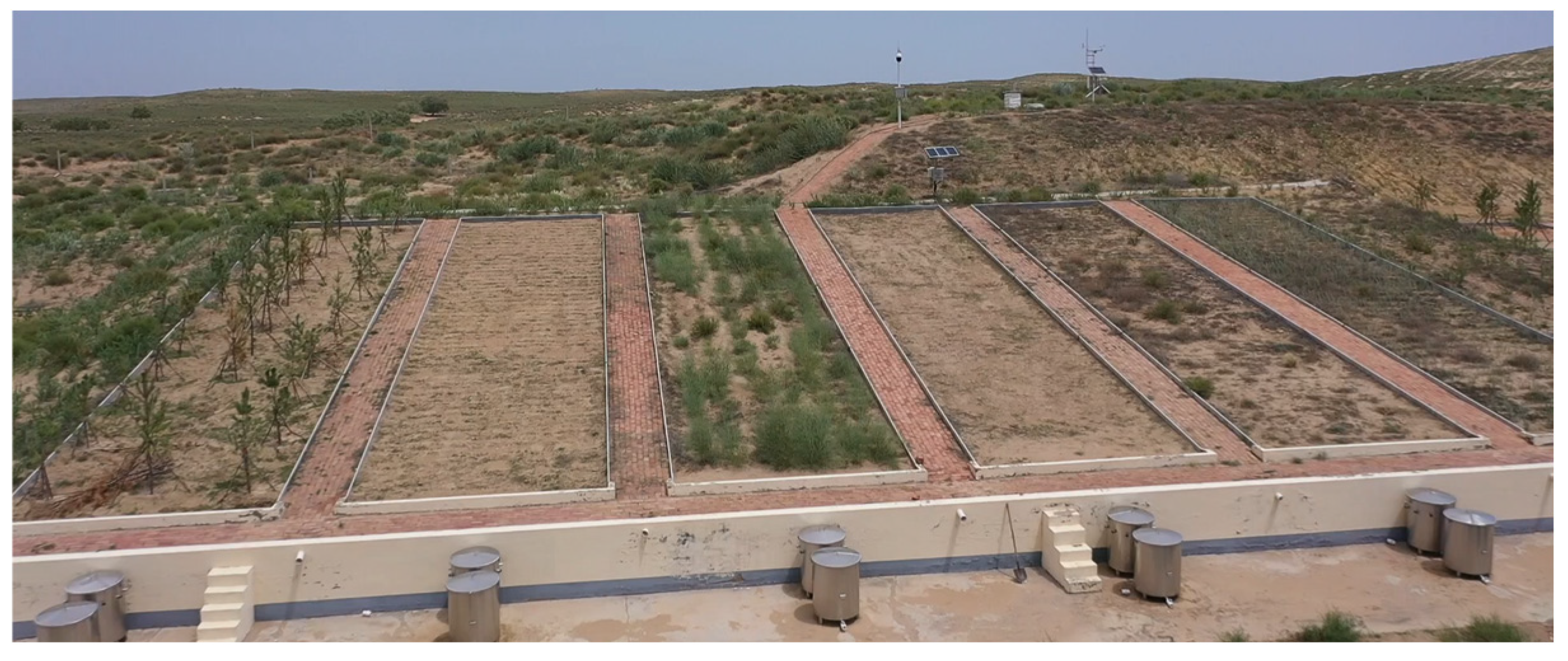
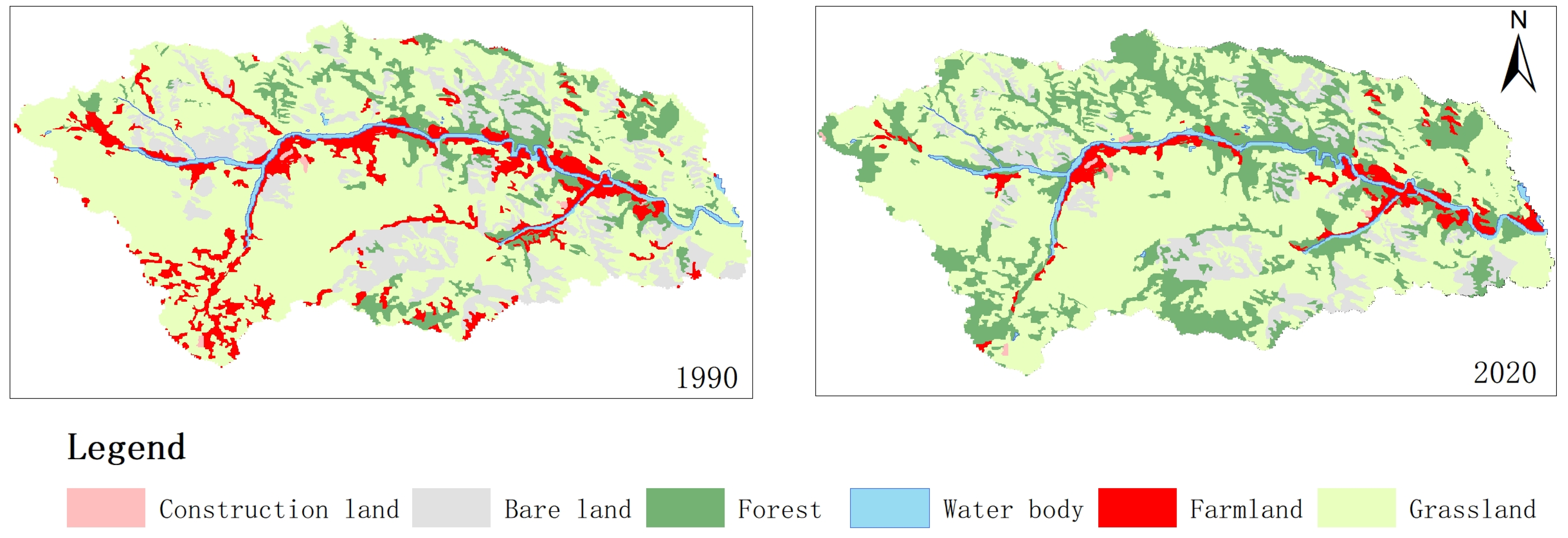
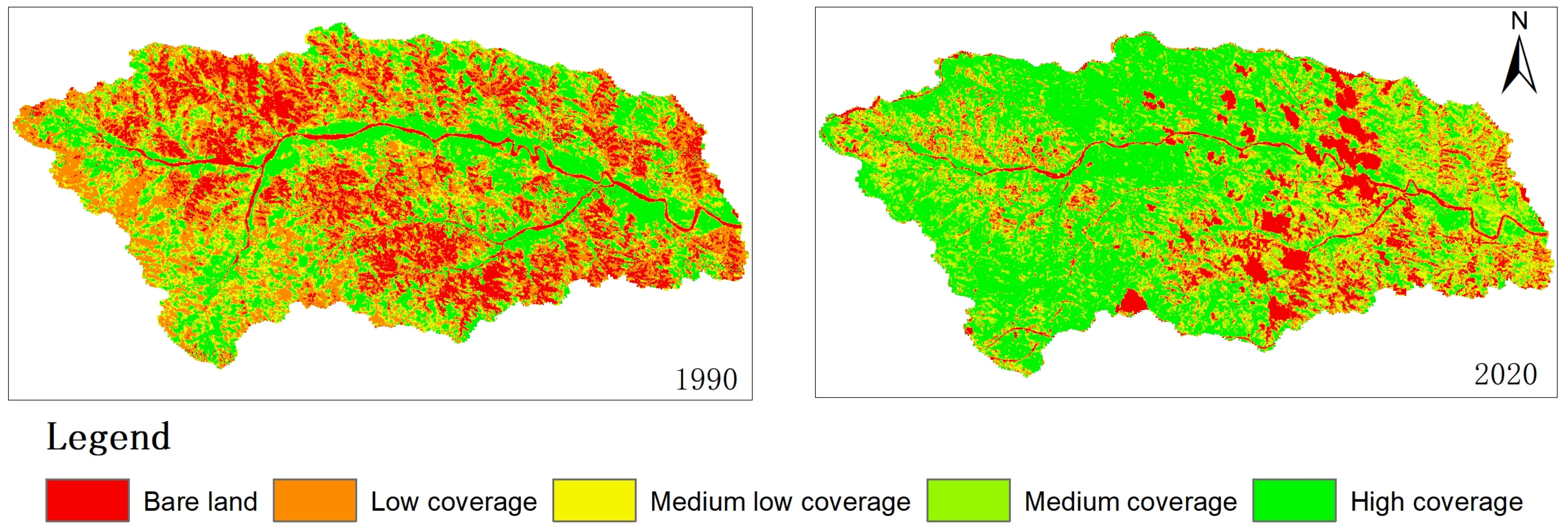

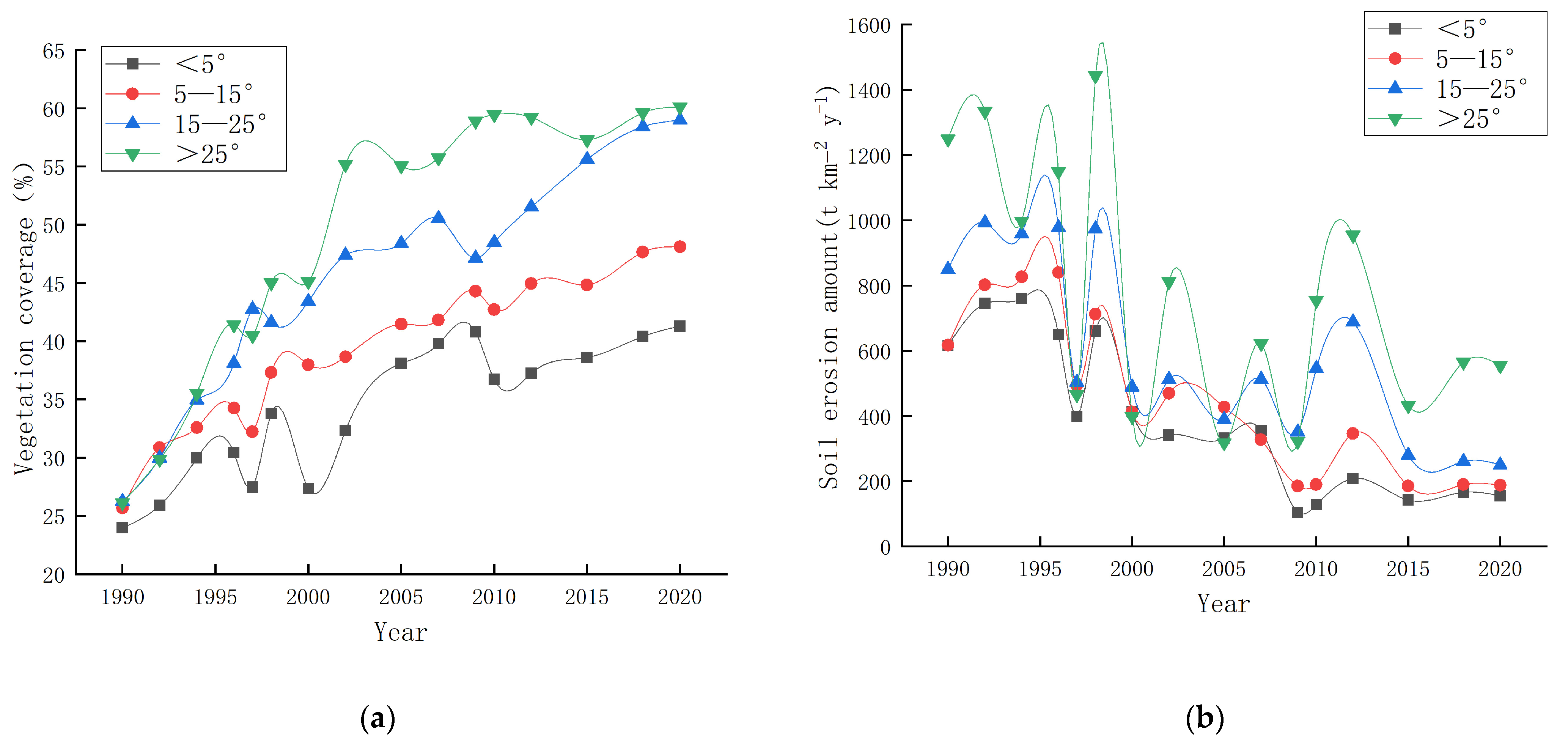

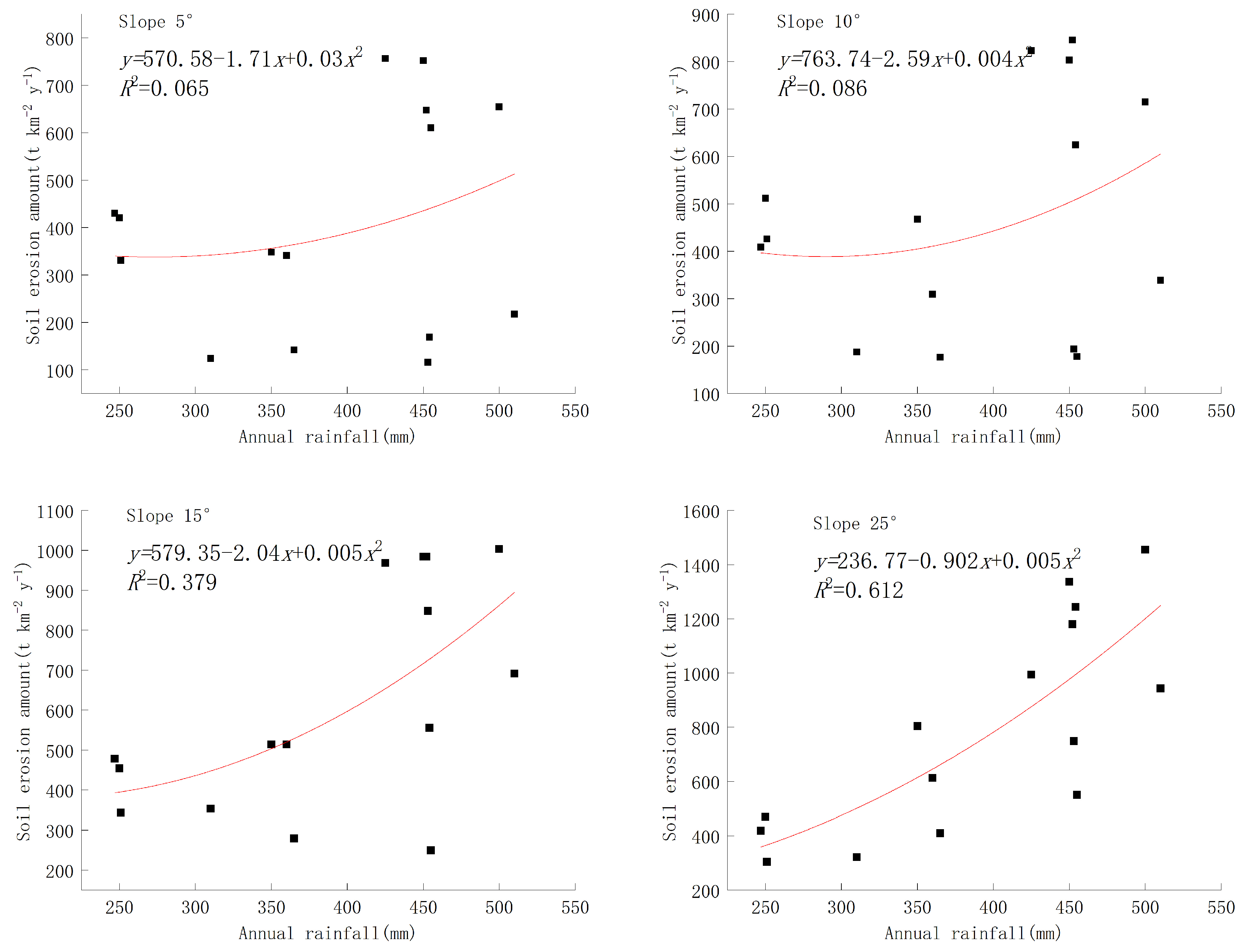
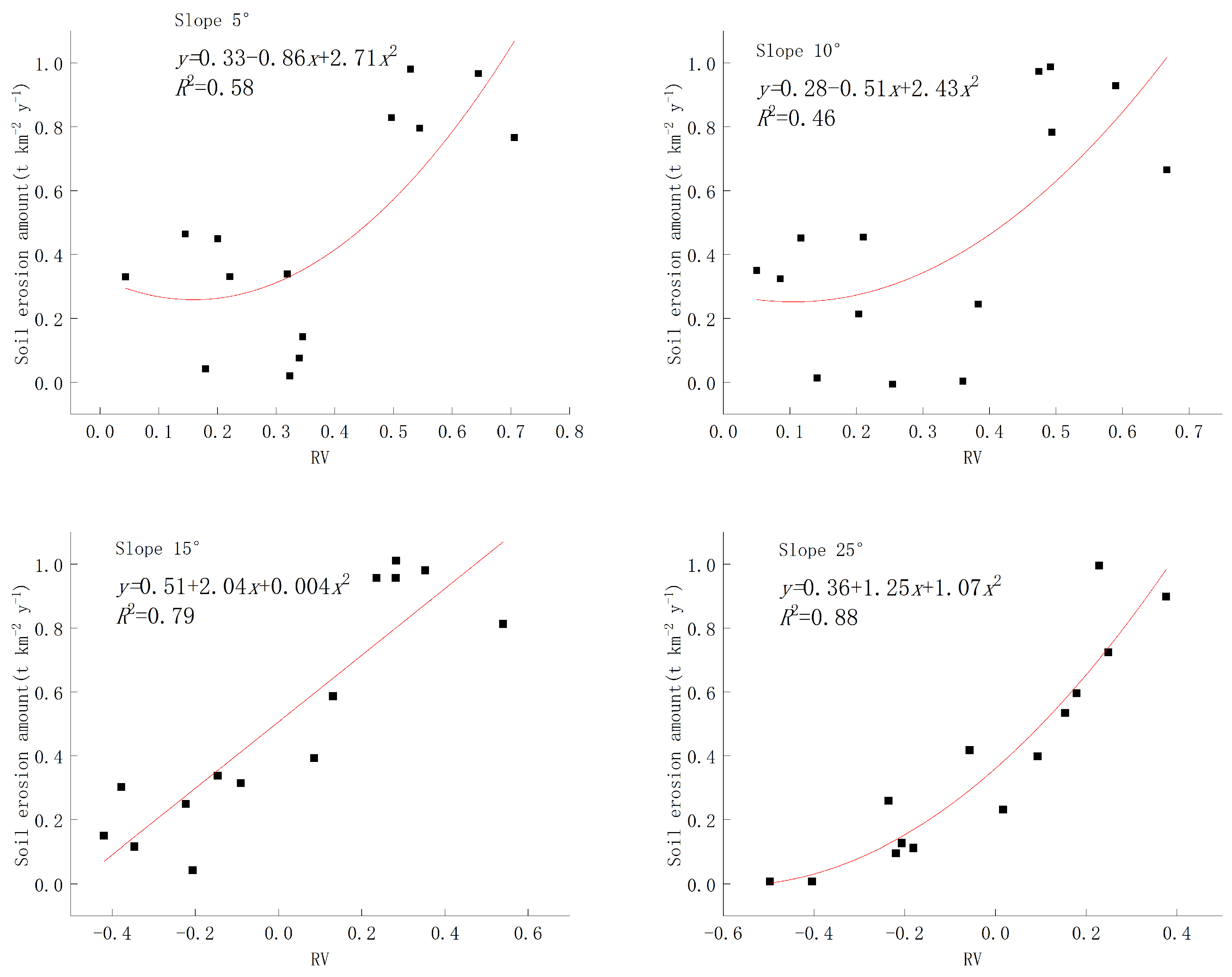
| Erosion Intensity | 1990 Proportion | 1995 Proportion | 2000 Proportion | 2005 Proportion | 2010 Proportion | 2015 Proportion | 2020 Proportion |
|---|---|---|---|---|---|---|---|
| Bare land | 42.74 | 38.10 | 27.42 | 26.68 | 26.76 | 25.96 | 22.13 |
| Low coverage | 87.93 | 83.09 | 53.44 | 48.09 | 60.13 | 56.70 | 41.06 |
| Medium-low coverage | 19.19 | 22.28 | 26.33 | 28.96 | 26.94 | 27.89 | 30.13 |
| Medium coverage | 22.72 | 25.60 | 40.13 | 42.67 | 37.31 | 41.30 | 51.10 |
| High coverage | 51.64 | 55.15 | 76.90 | 77.81 | 73.08 | 72.38 | 79.80 |
| Erosion Intensity | 1990 Proportion | 1995 Proportion | 2000 Proportion | 2005 Proportion | 2010 Proportion | 2015 Proportion | 2020 Proportion |
|---|---|---|---|---|---|---|---|
| Low erosion | 40.02 | 59.90 | 62.92 | 64.90 | 72.12 | 78.12 | 80.77 |
| Slight erosion | 44.09 | 58.48 | 63.13 | 74.43 | 86.36 | 84.23 | 84.61 |
| Moderate erosion | 84.52 | 74.00 | 70.99 | 66.44 | 62.31 | 58.44 | 57.17 |
| High erosion | 54.99 | 30.37 | 26.43 | 18.45 | 3.13 | 3.13 | 1.64 |
| Severe erosion | 0.60 | 1.47 | 0.75 | 0.01 | 0.30 | 0.30 | 0.03 |
Disclaimer/Publisher’s Note: The statements, opinions and data contained in all publications are solely those of the individual author(s) and contributor(s) and not of MDPI and/or the editor(s). MDPI and/or the editor(s) disclaim responsibility for any injury to people or property resulting from any ideas, methods, instructions or products referred to in the content. |
© 2024 by the authors. Licensee MDPI, Basel, Switzerland. This article is an open access article distributed under the terms and conditions of the Creative Commons Attribution (CC BY) license (https://creativecommons.org/licenses/by/4.0/).
Share and Cite
Yang, Z.; Guo, J.; Qin, F.; Li, Y.; Wang, X.; Li, L.; Liu, X. Spatiotemporal Variability of Soil Erosion in the Pisha Sandstone Region: Influences of Precipitation and Vegetation. Sustainability 2024, 16, 9313. https://doi.org/10.3390/su16219313
Yang Z, Guo J, Qin F, Li Y, Wang X, Li L, Liu X. Spatiotemporal Variability of Soil Erosion in the Pisha Sandstone Region: Influences of Precipitation and Vegetation. Sustainability. 2024; 16(21):9313. https://doi.org/10.3390/su16219313
Chicago/Turabian StyleYang, Zhenqi, Jianying Guo, Fucang Qin, Yan Li, Xin Wang, Long Li, and Xinyu Liu. 2024. "Spatiotemporal Variability of Soil Erosion in the Pisha Sandstone Region: Influences of Precipitation and Vegetation" Sustainability 16, no. 21: 9313. https://doi.org/10.3390/su16219313
APA StyleYang, Z., Guo, J., Qin, F., Li, Y., Wang, X., Li, L., & Liu, X. (2024). Spatiotemporal Variability of Soil Erosion in the Pisha Sandstone Region: Influences of Precipitation and Vegetation. Sustainability, 16(21), 9313. https://doi.org/10.3390/su16219313






